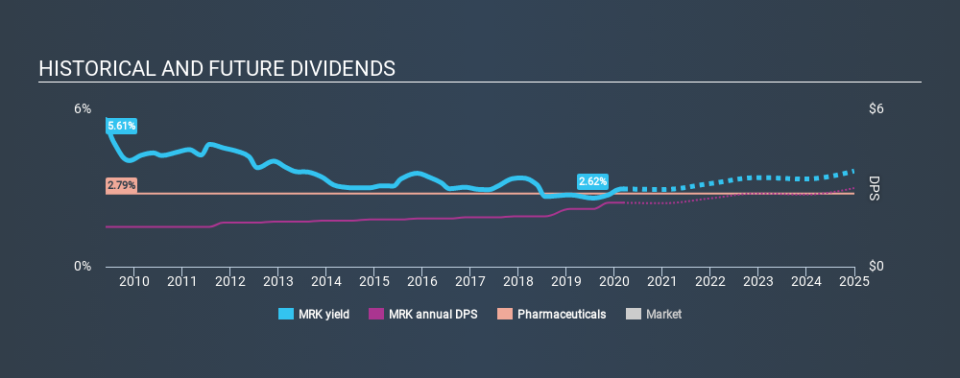Why It Might Not Make Sense To Buy Merck & Co., Inc. (NYSE:MRK) For Its Upcoming Dividend

Some investors rely on dividends for growing their wealth, and if you're one of those dividend sleuths, you might be intrigued to know that Merck & Co., Inc. (NYSE:MRK) is about to go ex-dividend in just 4 days. If you purchase the stock on or after the 13th of March, you won't be eligible to receive this dividend, when it is paid on the 7th of April.
Merck's upcoming dividend is US$0.61 a share, following on from the last 12 months, when the company distributed a total of US$2.44 per share to shareholders. Last year's total dividend payments show that Merck has a trailing yield of 3.0% on the current share price of $82.2. We love seeing companies pay a dividend, but it's also important to be sure that laying the golden eggs isn't going to kill our golden goose! So we need to investigate whether Merck can afford its dividend, and if the dividend could grow.
Check out our latest analysis for Merck
If a company pays out more in dividends than it earned, then the dividend might become unsustainable - hardly an ideal situation. Merck paid out more than half (57%) of its earnings last year, which is a regular payout ratio for most companies. A useful secondary check can be to evaluate whether Merck generated enough free cash flow to afford its dividend. Dividends consumed 57% of the company's free cash flow last year, which is within a normal range for most dividend-paying organisations.
It's encouraging to see that the dividend is covered by both profit and cash flow. This generally suggests the dividend is sustainable, as long as earnings don't drop precipitously.
Click here to see the company's payout ratio, plus analyst estimates of its future dividends.
Have Earnings And Dividends Been Growing?
Companies that aren't growing their earnings can still be valuable, but it is even more important to assess the sustainability of the dividend if it looks like the company will struggle to grow. If earnings decline and the company is forced to cut its dividend, investors could watch the value of their investment go up in smoke. That explains why we're not overly excited about Merck's flat earnings over the past five years. We'd take that over an earnings decline any day, but in the long run, the best dividend stocks all grow their earnings per share.
Another key way to measure a company's dividend prospects is by measuring its historical rate of dividend growth. In the last ten years, Merck has lifted its dividend by approximately 4.8% a year on average.
Final Takeaway
From a dividend perspective, should investors buy or avoid Merck? While earnings per share are flat, at least Merck has not committed itself to an unsustainable dividend, with its earnings and cashflow payout ratios within reasonable bounds. It's not an attractive combination from a dividend perspective, and we're inclined to pass on this one for the time being.
With that being said, if you're still considering Merck as an investment, you'll find it beneficial to know what risks this stock is facing. For example - Merck has 2 warning signs we think you should be aware of.
A common investment mistake is buying the first interesting stock you see. Here you can find a list of promising dividend stocks with a greater than 2% yield and an upcoming dividend.
If you spot an error that warrants correction, please contact the editor at editorial-team@simplywallst.com. This article by Simply Wall St is general in nature. It does not constitute a recommendation to buy or sell any stock, and does not take account of your objectives, or your financial situation. Simply Wall St has no position in the stocks mentioned.
We aim to bring you long-term focused research analysis driven by fundamental data. Note that our analysis may not factor in the latest price-sensitive company announcements or qualitative material. Thank you for reading.

 Yahoo Finance
Yahoo Finance 
